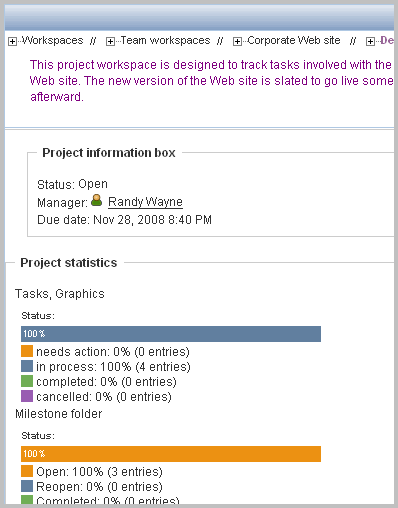3.3 Workspaces
This section describes different types of workspaces available in Novell Teaming.
This section contains the following subsections:
3.3.1 Global Workspaces
Global workspaces contain information beyond the scope of teamwork that might be of interest broadly across your organization. Given our sample installation, the example in the graphic that follows shows how the Global workspaces can be structured for the fictional Acme company:
Figure 3-57 Structuring Global Workspaces By Geography and Then By Function

This example uses geography to organize the Acme company’s global information, and then uses departmental categories (, , ) to further organize the information. Depending on your organization, you might want to reverse the order (function followed by geography) or use some other organizational scheme.
NOTE:We strongly recommend that you limit the creation of Global workspaces. First, organic team creation is the more effective use model for this product. Second, we have worked with a significant number of customers who duplicated complex organizational charts in the structure of Global workspaces, and users found them to be confusing and unusable. Instead, populate the Global area with a minimal amount of information, and let users guide you as to a useful structure and content in this area.
3.3.2 Personal Workspaces
Personal workspaces provide a home page or start page for your work in Novell Teaming. Personal workspaces include contact information, a guestbook, pictures of you, your personal blog, and more.
Previous topics in this document describe personal workspaces (see Section 2.2, Modifying Your Personal Workspace).
3.3.3 Team Workspaces
Team workspaces provide dedicated workspaces for a small group of people to coordinate their efforts and to collaborate.
Previous chapters in this book describe team workspaces (see Section 2.3, Creating a Team Workspace).
3.3.4 Project Workspaces
Project workspaces include special accessories that help a leader to track the progress of task completion for a potentially large project. Although project workspaces can contain any type of folder, they are specifically designed to work in conjunction with task and milestone folders.
In our sample installation, there is a corporate Web site development team. This team has begun a project that requires them to redesign the web site for a December 2008 deadline. So, the team created a team workspace for general Web site teamwork, and, within that space, it created a project workspace for the Web site redesign:
Figure 3-58 A Project Workspace Within a Team Workspace
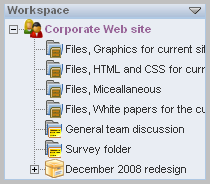
Within the project workspace, the project leader created standard folders (a discussion area and file folders for various types of files used in the project), a wiki folder to create page content for the Web site, and three task folders for several categories of work involved in this project effort:
Figure 3-59 Task Categories and Their Folders
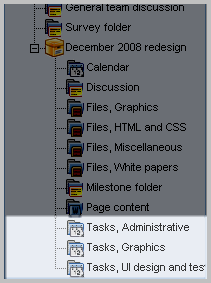
Each task folder contains tasks that fit that task category. The next graphic shows a picture of a task folder:
Figure 3-60 A Task Folder
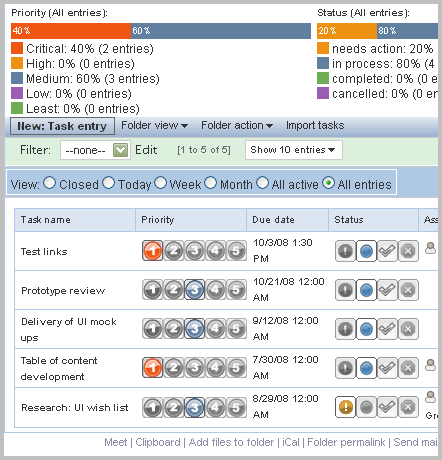
This is the folder. Novell Teaming produces the and summaries, by using the individual task data provided in the table toward the bottom of the folder. For example, in the summary toward the top of the previous graphic, 40% of the individual tasks are marked , and 60% are marked . If the assigned person or the project leader changes the priority value of an individual task, Novell Teaming recalculates the summary located at the top of the folder. Finally, Novell Teaming displays radio-button filters at the top of the individual task listing that allow you to see only closed or active tasks, or allow you to see only tasks due today, this week, and so on.
A designated individual can change the , , or value for a task right on the folder page. For example, if you mouse over the bar in the column, Novell Teaming displays a percentage value that corresponds to the location of the mouse. When the appropriate percentage is displayed, click the mouse, and Novell Teaming adjusts the value:
Figure 3-61 Changing the % Done Value of a Task
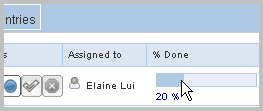
Novell Teaming allows you to import tasks from other software applications. You can import tasks from Outlook* or from other applications that export to files of these formats: .ical, .ics, .ifb, and .icalendar. To import tasks, view the task folder into which you want to import tasks, click on the toolbar, specify the file containing the tasks, and click .
Individual task status in one task folder is rolled up into the summary for that folder. The status values for each task folder roll up again into the milestone folder:
Figure 3-62 A Milestone Folder
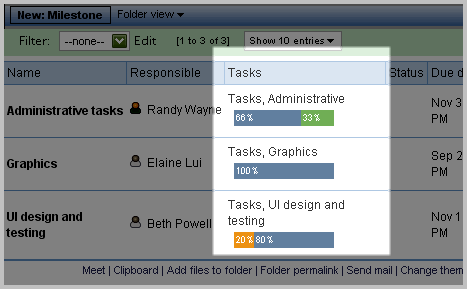
The milestones folder provides a snapshot of the status of each of the three task folders in our sample installation. Mouse over the colors in the bar chart, and Novell Teaming explains the value (needs action, in progress, completed).
Finally, the information rolls up one more time, into the project-workspace page:
Figure 3-63 A Project Workspace Page
